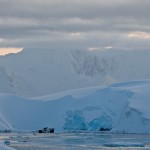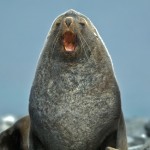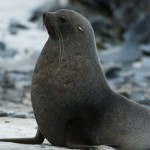We haven’t seen much of the sun at all in the past few days, as winds and storms have kept us from both work and play. Indeed, our trip ashore to Palmer Station was truncated by growing winds and driving snow. Needless to say, everyone wanted a bit more time ashore – but I think most got what they needed from the crowded gift shop.
It was short but sweet Palmer Station – we hope you have a great winter!
Experiencing the Antarctic during the late autumn is a privilege, and something I wish I could share with many. When it is clear, the short daylight hours are perfused by sunlight that has traveled through miles and miles of the earth’s atmosphere – giving it that ethereal quality Maria Stenzel blogged about previously in her entry entitled Full Moon Memories. As we move from bay to bay in this eerie light, making our observations and learning new things, it would be easy to assume that what we see is in a pristine state, in a state before their was wilderness, before humans established the lines between wild and domestic. The panoramas are breathtaking, and the signal-to-noise ratio of life is immense. At first glance, it seems perfect.
- Snow-covered wreck in Foyn Harbor
But, here and there we see subtle clues that this is might not be exactly the case – the wrecked whaling ship nearly hidden by snow at Foyn Harbor, the plastic debris that Pat collected the other day. These things hint at previous and ongoing insults that touch even the ends of the earth. As scientists with an interest in history we know that the idea of a pristine Antarctic (or a pristine place anywhere on earth) is a myth. This place has certainly seen its share of damage and destruction, and has displayed an astonishing amount of resilience. Probably one of the most amazing stories of destruction and rebirth is found in the history of Antarctic fur seals (Arctocephalus gazella) of the Western Antarctic Peninsula (WAP) Region. We see Antarctic fur seals frequently in these waters during our surveys. They seem to be everywhere – reclining on ice floes, popping up beside the Palmer to have a quick look or porpoising away from us in large groups, on their way to somewhere.
There was a time – not so long ago – that fur seals were scarce in the WAP region. The largest breeding colonies of fur seals in the region are found in the South Shetland Islands, just north of where were are now. When the South Shetlands were discovered in 1819, there were large colonies of fur seals throughout the archipelago. Within months of this initial discovery, these islands became the epicenter of large-scale commercial sealing activities that lasted into the 1870s. For example, in the summer of 1821/1822 alone, approximately 95,000 fur seals were reported taken by 5 crews of sealers. These activities, conducted primarily by North American and British sealers, produced pelts that were sold in London and China for clothing and hats. Interestingly, Nathaniel B. Palmer – our ship’s namesake – was one of these sealers, and it was during that season he first set foot on the Antarctic continent. The initial outcome of these intensive sealing activities was the near-extermination of fur seals from the entire archipelago.
- Antarctic Fur seal
Despite our best attempts to convert fur seals entirely into cash, they have persisted in the wild. A remnant fur seal was killed at Nelson Island during the Swedish South Polar Expedition of 1901-1903 and in January 1958 a small colony of 27 animals was discovered on Cape Shirreff, Livingston Island. From this small colony the species has begun to recover and to re-establish its place as an important component of the WAP marine ecosystem. Fur seals now appear to be relatively abundant in these waters, as colony counts and our observations can attest to. Indeed, recent estimates indicate that the population of Antarctic fur seals at Livingston Island in the South Shetlands has stabilized at approximately 21,000 animals. This is however, only about 12 percent of the original estimates for Antarctic fur seals at that location.
- Fur seals rest on an ice floe.
While these animals have recovered from the brink, the ecosystem of the WAP remains forever changed. Fur seal numbers in the South Shetlands have grown and stabilized, but at a fraction of what was believed to exist before sealing began. To the untrained eye, to those without knowledge of prior unfettered commercial exploitation, the system may seem complete and pristine. However, those of us sailing these icy waters know differently, we can see past the illusion. Indeed, as Aldo Leopold wrote in Round River: From the journals of Aldo Leopold: “One of the penalties of an ecological education is that one lives alone in a world of wounds.” This is my challenge, and a crucial task for all others who see the world through an ecological filter. We need to make everyone see the wounds of the world for what they are – even in a place as beautiful as this.




UMM..
Excuse me, could you please write more about shooting whales with crossbows? I can’t quite get enough of the part where you shoot them with crossbows, it’s my favorite thing.
heart.
-chance.